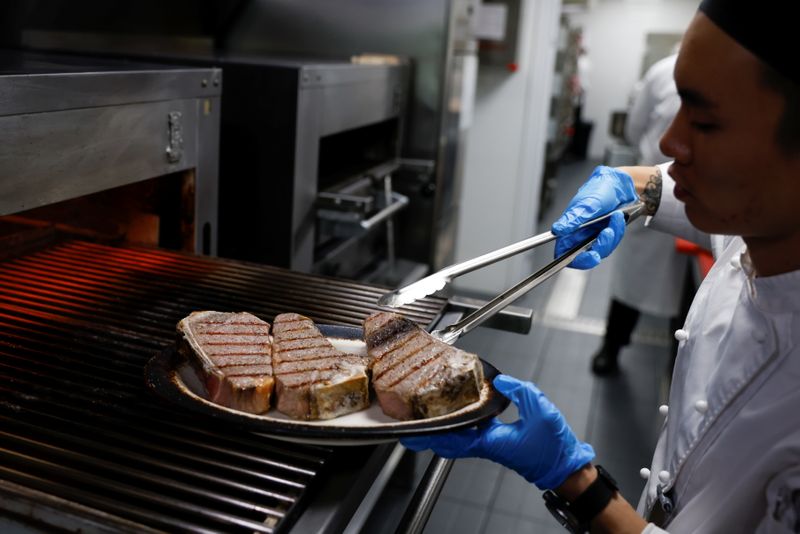By Dominique Patton and Tom Polansek
BEIJING/CHICAGO (Reuters) - As Australian beef exports to China wither amid diplomatic tensions, demand there for U.S. grain-fed beef has soared, fuelled by the appetites of a growing Chinese middle class.
Hotpot restaurants, Japanese barbecue chains and steakhouses, all expanding in the world's No. 2 economy, are swapping out Australian beef for U.S. meat. Several Australian suppliers were banned last year and shipments from others take too long to clear customs.
Beef imports from the U.S. have grown to 83,000 tonnes in the first eight months of 2021, nine times the amount in the same period a year ago, according to Chinese customs data, and are set to be worth more than $1 billion this year. Australia also fell behind the United States this year as the top exporter of grain-fed beef to China.
"They don't have a lot of other options when it comes to the well-marbled, grain-fed product," said Joe Schuele, spokesman at the U.S. Meat Export Federation (USMEF). "That's the product that really stands out in China."
Deteriorating relations between Beijing and Canberra have hurt supplies from Australia. Five of its largest factories were suspended by Beijing last year for reasons such as poor labelling and contamination with a banned substance.
Though other plants are still allowed to ship to China, importers say they face long delays.
Beef imports from Australia in the first eight months fell to 96,000 tonnes, half of what they were in the same period last year, China customs data shows.
"We've been told it will take at least 85 days to clear," said a Beijing-based importer who has six containers of frozen Australian beef stuck in Shanghai port and has begun offering Tyson beef to his restaurant clients.
That compares with about one week for meat from other origins. China's General Administration of Customs did not respond to a request for comment.
Sino-Australian ties have been strained since 2018 and worsened last year when Australia called for an independent investigation into the origins of the novel coronavirus, prompting trade reprisals from China.
GRAIN-FED DEMAND
Grass-fed beef, a premium product in other markets, typically goes to cheaper channels in China, such as mass-market restaurants and supermarkets.
Last year imports accounted for 40% of China's beef consumption, or about 2 million tonnes. Though supplies are dominated by low-cost grass-fed producers Brazil, Argentina and Uruguay, demand from mass-market consumers is slowing amid a weaker economy.
China's mid- to high-end market - where grain-fed rules - continues to grow, however, as consumers "trade up, eat better", said Pan Chenjun, senior analyst at Rabobank.
China's middle class spent $7.3 trillion in 2020, more than any other country's, according to a report by U.S. research group Brookings, and is still growing, with young people accounting for more spending than in other countries.
New York chain Wolfgang's Steakhouse, which has two restaurants in Beijing, opened another in the southern city of Shenzhen this year and has plans for a fourth in Hangzhou.
The restaurant flies in chilled U.S. beef before ageing it. Its 800g rib-eyes cost $150 apiece.
"Young people like meat, especially 20- and 30-year-olds who come here on dates," said Glen Feng, manager of the Beijing outlets.
China beef imports by supplier, January-August https://graphics.reuters.com/CHINA-BEEF/klvykgrnrvg/chart.png
TRADE TIES
Even as China's beef demand has surged in recent years, driven by a growing middle class, politics have reshuffled the country's top importers.
Domestic production costs, meanwhile, make local supplies of grain-fed beef erratic, said Zhong Dingming, the manager of Jingli hotpot restaurant in Beijing. He said imported beef like the Tyson short ribs he buys offers better quality for a slightly higher price.
In last year's Phase 1 trade deal between Beijing and Washington, China agreed that U.S.-approved processing plants could access its market without Chinese inspections.
The number of facilities allowed to ship to China has jumped to more than 500.
TREX Corp, a U.S. meat exporter owned by Greater Omaha Packing Co, is buying meat from other packers to ship to China as demand climbs, said Henry Davis, chief executive of Greater Omaha.
In China, USMEF has doubled the number of training events teaching local chefs how best to cut and slice, said Joel Haggard, senior vice president for the Asia Pacific.
Value of U.S. beef exports to China https://graphics.reuters.com/CHINA-BEEF/lbvgngxjmpq/chart.png
Shanghai-based retailer Swiss Butchery said it had stocked up on American beef as Australian supplies became less reliable. The store now sells American wagyu for 1,430 yuan ($221.87)per kilogramme, on occasion selling 10 kilogrammes at a time, said general manager Jaap Zuidervliet.
U.S. beef that meets China's import standards is in tight supply and the European Union is competing to buy the same meat, said Omaha's Davis.
And though Australia's beef exporters have turned to Japan and South Korea, a well-established reputation means customers in China could quickly return if things change.
"Australian beef still has a reputation for top quality and being natural. Long-term we're still really bullish on China," said Andrew Cox, general manager of international markets at trade body Meat and Livestock Australia.
($1 = 6.4452 Chinese yuan renminbi)
